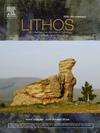Petrogenesis and tectonic significance of the late Middle Triassic I-type granite in the eastern section of the North Qilian tectonic belt: Constraints on the initiation of post-collision between North China Block and South China Block
IF 2.9
2区 地球科学
Q2 GEOCHEMISTRY & GEOPHYSICS
引用次数: 0
Abstract
A significant number of Triassic granitic plutons are exposed at the junction of the Qinling and Qilian Orogenic Belts. The Early Triassic to early Middle Triassic granites are distributed in a linear or zonal fashion, trending northwest–southeast, which aligns with the regional tectonic lines. In contrast, the late Middle Triassic to Late Triassic granites exhibit a more diverse distribution, appearing as isolated points or planes that are not constrained by tectonic unit boundaries. These granites provide essential insights into the tectonic evolution of the Qinling Orogenic Belt and the junction of the Qinling and Qilian Orogenic Belts during the Triassic. In this study, we conducted petrological, geochemical, zircon U![]() Pb dating, and Lu
Pb dating, and Lu![]() Hf isotope analyses for Longyang I-type monzogranite located in the eastern section of the North Qilian Tectonic Belt. The results indicate that the crystallization age of the Longyang pluton is 237.6 ± 1.3 Ma, corresponding to an emplacement age in the late Middle Triassic. The Longyang pluton belongs to metaluminous (A/CNK = 0.88 to 0.97) and high-K calc-alkaline series. The pluton displays an enriched large-ion lithophile elements and light rare earth elements, depleted high field strength elements and heavy rare earth elements pattern, with no significant Eu anomaly. The Hf isotopic composition of the Longyang pluton reveals εHf(t) values ranging from −5.4 to −0.8, with a two-stage model age (TDM2) between 1291 and 1580 Ma, indicating that its magmatic source is derived from the partial melting of the Mesoproterozoic thickened lower crust. Combined with the mineralogy, geochemical features and regional tectonic background, we propose a post-collision setting. These findings indicate that the subduction of the A'nimaque–Mianlue Ocean had completed around 237 Ma, marking the onset of a comprehensive transition from compression to extension stage for the North China Block and the South China Block. Furthermore, they suggest that the eastern section of the North Qilian Tectonic Belt entered the post-collision initiation stage in the late Middle Triassic.
Hf isotope analyses for Longyang I-type monzogranite located in the eastern section of the North Qilian Tectonic Belt. The results indicate that the crystallization age of the Longyang pluton is 237.6 ± 1.3 Ma, corresponding to an emplacement age in the late Middle Triassic. The Longyang pluton belongs to metaluminous (A/CNK = 0.88 to 0.97) and high-K calc-alkaline series. The pluton displays an enriched large-ion lithophile elements and light rare earth elements, depleted high field strength elements and heavy rare earth elements pattern, with no significant Eu anomaly. The Hf isotopic composition of the Longyang pluton reveals εHf(t) values ranging from −5.4 to −0.8, with a two-stage model age (TDM2) between 1291 and 1580 Ma, indicating that its magmatic source is derived from the partial melting of the Mesoproterozoic thickened lower crust. Combined with the mineralogy, geochemical features and regional tectonic background, we propose a post-collision setting. These findings indicate that the subduction of the A'nimaque–Mianlue Ocean had completed around 237 Ma, marking the onset of a comprehensive transition from compression to extension stage for the North China Block and the South China Block. Furthermore, they suggest that the eastern section of the North Qilian Tectonic Belt entered the post-collision initiation stage in the late Middle Triassic.

北祁连构造带东段晚中三叠世I型花岗岩的岩石成因及构造意义:华北地块与华南地块碰撞后启动的制约因素
本文章由计算机程序翻译,如有差异,请以英文原文为准。
求助全文
约1分钟内获得全文
求助全文
来源期刊

Lithos
地学-地球化学与地球物理
CiteScore
6.80
自引率
11.40%
发文量
286
审稿时长
3.5 months
期刊介绍:
Lithos publishes original research papers on the petrology, geochemistry and petrogenesis of igneous and metamorphic rocks. Papers on mineralogy/mineral physics related to petrology and petrogenetic problems are also welcomed.
 求助内容:
求助内容: 应助结果提醒方式:
应助结果提醒方式:


